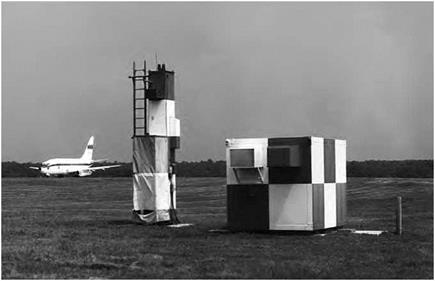Aviation Safety Reporting System: 1975
On December 1, 1974, a Trans World Airlines (TWA) Boeing 727, on final approach to Dulles airport in gusty winds and snow, crashed into a Virginia mountain, killing all aboard. Confusion about the approach to the airport, the navigation charts the pilots were using, and the instructions from air traffic controllers all contributed to the accident. Six weeks earlier, a United Airlines flight nearly succumbed to the same fate. Officials concluded, among other things, that a safety awareness program might have enabled the TWA flight to benefit from the United flight’s experience. In May 1975, the FAA announced the start of an Aviation Safety Reporting Program to facilitate that kind of communication. Almost immediately, it was realized the program would fail because of fear the FAA would retaliate against someone calling into question its rules or personnel. A neutral third party was needed, so the FAA turned to NASA for the job. In August 1975, the agreement was signed, and NASA officially began operating a new Aviation Safety Reporting System (ASRS).[203]
NASA’s job with the ASRS was more than just emptying a "big suggestion box” from time to time. The memorandum of agreement between the FAA and NASA proposed that the updated ASRS would have four functions:
1. Take receipt of the voluntary input, remove all evidence of identification from the input, and begin initial processing of the data.
2. Perform analysis and interpretation of the data to identify any trends or immediate problems requiring action.
3. Prepare and disseminate appropriate reports and other data.
4. Continually evaluate the ASRS, review its performance, and make improvements as necessary.
Two other significant aspects of the ASRS included a provision that no disciplinary action would be taken against someone making a safety report and that NASA would form a committee to advise on the ASRS. The committee would be made up of key aviation organizations, including the Aircraft Owners and Pilots Association, the Air Line Pilots Association, the Aviation Consumer Action Project, the National Business Aircraft Association, the Professional Air Traffic Controllers Organization, the Air Transport Association, the Allied Pilots Association, the American Association of Airport Executives, the Aerospace Industries Association, the General Aviation Manufacturers’ Association, the Department of Defense, and the FAA.[204]
Now in existence for more than 30 years, the ASRS has racked up an impressive success record of influencing safety that has touched every aspect of flight operations, from the largest airliners to the smallest general-aviation aircraft. According to numbers provided by NASA’s Ames Research Center at Moffett Field, CA, between 1976 and 2006, the ASRS received more than 723,400 incident reports, resulting in 4,171 safety alerts being issued and the instigation of 60 major research studies. Typical of the sort of input NASA receives is a report from a Mooney 20 pilot who was taking a young aviation enthusiast on a sightseeing flight and explaining to the passenger during his landing approach what he was doing and what the instruments were telling him. This distracted his piloting just enough to complicate his approach and cause the plane to flare over the runway. He heard his stall alarm sound, then silence, then another alarm with the same tone. Suddenly, his aircraft hit the runway, and he skidded to a stop just off the pavement. It turned out that the stall warning alarm and landing gear alarm sounded alike. His suggestion was to remind the general-aviation community there were verbal alarms available to remind pilots to check their gear before landing.[205]
Although the ASRS continues today, one negative about the program is that it is passive and only works if information is voluntarily offered. But from April 2001 through December 2004, NASA fielded the National Aviation Operations Monitoring Service (NAOMS) and conducted almost 30,000 interviews to solicit specific safety-related data from pilots, air traffic controllers, mechanics, and other operational personnel. The aim was to identify systemwide trends and establish performance measures, with an emphasis on tracking the effects of new safety-related procedures, technologies, and training. NAOMS was part of NASA’s Aviation Safety Program, detailed later in this case study.[206]
With all these data in hand, more coming in every day, and none of them in a standard, computer-friendly format, NASA researchers were prompted to develop search algorithms that recognized relevant text. The first such suite of software used to support ASRS was called QUOROM, which at its core was a computer program capable of analyzing, modeling, and ranking text-based reports. NASA programmers then enhanced QUOROM to provide:
• Keyword searches, which retrieve from the ASRS database narratives that contain one or more user-specified keywords in typical or selected contexts and rank the narratives on their relevance to the keywords in context.
• Phrase searches, which retrieve narratives that contain user-specified phrases, exactly or approximately, and rank the narratives on their relevance to the phrases.
• Phrase generation, which produces a list of phrases from the database that contain a user-specified word or phrase.
• Phrase discovery, which finds phrases from the database that are related to topics of interest.[207]
QUORUM’s usefulness in accessing the ASRS database would evolve as computers became faster and more powerful, paving the way for a new suite of software to perform what is now called "data mining.” This in turn would enable continual improvement in aviation safety and
|
Microwave Landing System hardware at NASA’s Wallops Flight Research Facility in Virginia as a NASA 737 prepares to take off to test the high-tech navigation and landing aid. NASA. |
find applications in everything from real-time monitoring of aircraft systems[208] to Earth sciences.[209]











